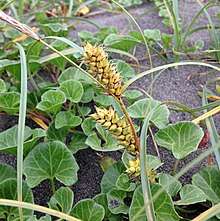Carex pumila
Carex pumila, commonly known as strand sedge or spreading sedge,[1] is a species of sedge of the family Cyperaceae.[2][3]
| Strand sedge | |
|---|---|
 | |
| Scientific classification | |
| Kingdom: | |
| (unranked): | |
| (unranked): | |
| (unranked): | |
| Order: | |
| Family: | |
| Genus: | |
| Species: | C. pumila |
| Binomial name | |
| Carex pumila | |
Description
The monoecious and rhizomatous perennial grass-like sedge has a tufted habit and typically grows to a height of 0.4 metres (1.3 ft). It blooms in summer usually between November and February in Australia producing brown flowers.[2] The foliage is deep blue-green with coarse tufts, arising from a long creeping rhizome with a diameter of about 2 millimetres (0.08 in). The culms are usually buried in sand and are 5 to 30 centimetres (2.0 to 11.8 in) in length. The culms are terete, smooth, cream or light green in colour but almost completely enclosed by light cream brown to red-brown sheaths. The leaves are longer than the culms, up to 40 cm (15.7 in) in length and about 2 mm (0.08 in) in width. The leaves are channelled, rigid, curved and taper to a fine point t the end.[3]
The seeds are oval shaped nuts and are 2 to 3 mm (0.08 to 0.12 in) in length.[1]
Taxonomy
The species was first formally described by the botanist Carl Peter Thunberg in 1784 as a part of Johan Andreas Murray's work Systema Vegetabilium. The name of this species is often misapplied to Carex bichenoviana.[4]
Distribution
The plant is widely distributed and is found in Australia, New Zealand, Lord Howe Island, Chile, China, Japan and Korea.[3]
Mostly found along the coast in dune areas but occasionally around the sandy margins of coastal rivers and estuaries. Also sometimes as an urban lawn weed, mostly in coastal settlements.[3]
It is found in coastal areas through much of temperate Australia from Queensland to Western Australia, including Tasmania.[1] In Western Australia it is found on sand dunes in the Peel and South West regions where it grows in sandy soils.[2]
See also
References
- "Family Index". Understorey Network. Retrieved 23 September 2017.
- "Carex pumila". FloraBase. Western Australian Government Department of Parks and Wildlife.
- "Carex pumila". New Zealand Plant Conservation Network. Retrieved 23 September 2017.
- "Carex pumila Thunb. ex Murray (misapplied to Carex bichenoviana)". Atlas of Living Australia. Global Biodiversity Information Facility. Retrieved 3 October 2017.